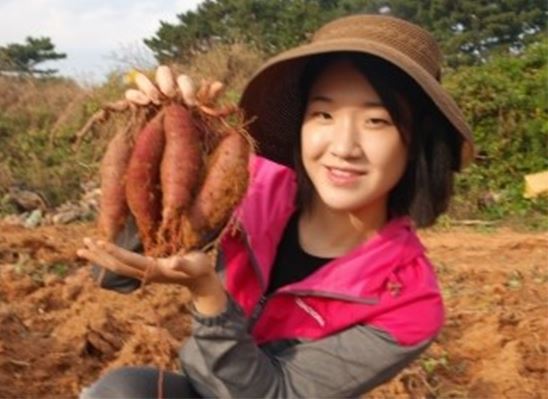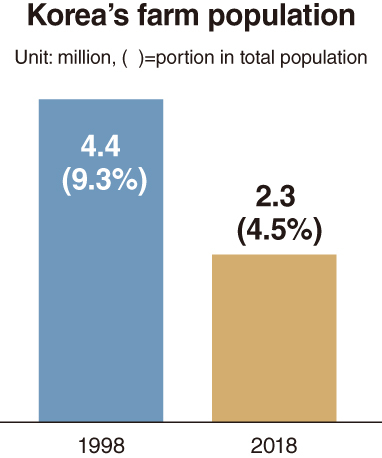[News Focus] South Korea’s farm population halves in 20 years
By Kim Yon-sePublished : Jan. 16, 2020 - 16:05
SEJONG -- Fifty years ago, the number of South Koreans engaged in agriculture accounted for more than 40 percent of the total population.
But the farming population (defined by the government as people in farming households) has continued to drop. It fell to below 30 percent of the total population in 1980 and was about 15 percent in 1990, according to government data.
The Ministry of Agriculture, Food and Rural Affairs noted that the farming population posted 4.4 million in 1998, accounting for 9.3 percent of the total population.
That further declined in the 2000s and 2010s -- to 8.8 percent in 2000, 6.2 percent in 2010, 5.8 percent in 2012, 5.4 percent in 2014, 4.9 percent in 2016 and 4.5 percent in 2018 (the latest figure).

This means an estimated farming population of 2.3 million in 2018, down 47.7 percent from 1998.
An Agriculture Ministry official attributed the steady decline to a shift in land use from agriculture to housing, and households abandoning farming due to poor returns.
In particular, he said the situation in rural areas has become more serious in terms of demographic structure – leading to a manpower shortage as young people steady relocate to cities.
He cited the state figure that the percentage of seniors, aged 65 or over, among the farming population was 43 percent (1 million out of 2.3 million) as of 2018, compared to 31.8 percent in 2000 and 16.2 percent in 1995.
By province, the farming population had the largest share of the total in South Jeolla, with 17.1 percent as of 2018, followed by North Gyeongsang (14.1 percent), South Chungcheong and Jeju (12.7 percent), North Jeolla (11.4 percent), and North Chungcheong (10.2 percent). Gyeonggi recorded the lowest of 2.3 percent among the nine provinces.
Among eight major cities, Sejong topped the list at 4.7 percent as the autonomous city includes a large rural area, trailed by Ulsan (2.5 percent), Gwangju (1.7 percent) and Daegu (1.6 percent). Seoul ranked at the bottom with 0.1 percent.

Between the 2010-2018 period, the number of men engaged in the agriculture sector fell from 1.5 million to 1.13 million. The number of females declined from 1.56 million to 1.18 million.
Over the past decade, the government has provided young urbanites in their 20s, 30s and 40s, who moved to rural areas and tapped the farming sector, with a variety of benefits, which aroused a trend to return to agriculture.
But it seems that the trend has waned, as many of them have failed to adapt themselves to rural life.
The problems they picked included difficulty getting along with their new neighbors, a lack of farming know-how and financial difficulties due to lower incomes.
According to the Agriculture Ministry, the number of people who still continued farm work after moving from urban areas stood at 17,856 (including household members) as of 2018, down 9 percent from 19,630 a year earlier.
It marked the second consecutive year of decline after the population having peaked at 20,559 in 2016.
A more worrisome point is that the 2018 figure was the lowest in five years since the government started compiling the data in 2013, when it was at 17,318.
In addition, the number of those who have relocated from cities to the countryside to “enjoy rural life, irrespective of work” also dropped on-year by 4.9 percent from 497,178 in 2017 to 472,474 in 2018.
They refer to residents who engage in services or retail businesses or do not take part in economic activities after moving to the countryside.
By Kim Yon-se (kys@heraldcorp.com)







![[KH Explains] Hyundai's full hybrid edge to pay off amid slow transition to pure EVs](http://res.heraldm.com/phpwas/restmb_idxmake.php?idx=644&simg=/content/image/2024/04/18/20240418050645_0.jpg&u=20240419100350)






![[From the Scene] Monks, Buddhists hail return of remains of Buddhas](http://res.heraldm.com/phpwas/restmb_idxmake.php?idx=652&simg=/content/image/2024/04/19/20240419050617_0.jpg&u=20240419175937)

![[KH Explains] Hyundai's full hybrid edge to pay off amid slow transition to pure EVs](http://res.heraldm.com/phpwas/restmb_idxmake.php?idx=652&simg=/content/image/2024/04/18/20240418050645_0.jpg&u=20240419100350)

![[Today’s K-pop] Illit drops debut single remix](http://res.heraldm.com/phpwas/restmb_idxmake.php?idx=642&simg=/content/image/2024/04/19/20240419050612_0.jpg&u=)